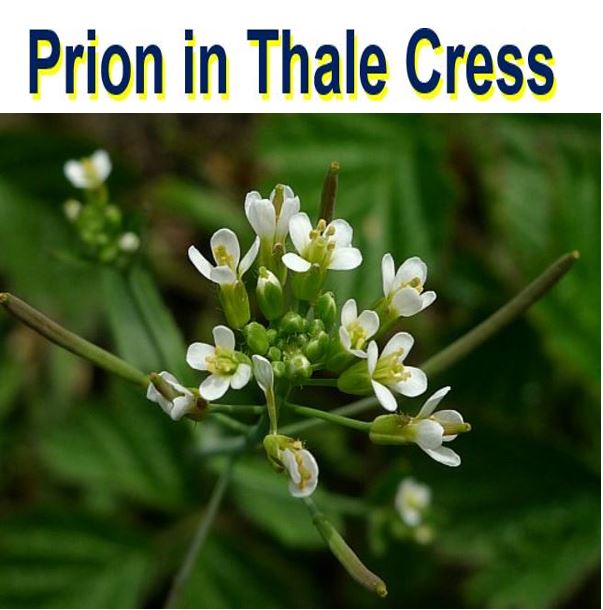Plants have memories, which they use to remember the best time of year to flower, for example. These memories exist thanks to a misfolded protein called Luminidependens, which is normally involved in controlling flowering time and responding to daylight.
Plants also have the ability to pass on those memories to their offspring, so that future generations come into this world with a better chance of surviving and reproducing.
The misfolded protein is, in fact, a type of prion, which is better known for causing degenerative illnesses in animals, including humans.
 Thale cress (above). For the first time, researchers may have discovered prion-like proteins in plants. They suggest that the proteins help plants remember how to respond to conditions like cold and drought. (Image: wildflowerfinder.org.uk)
Thale cress (above). For the first time, researchers may have discovered prion-like proteins in plants. They suggest that the proteins help plants remember how to respond to conditions like cold and drought. (Image: wildflowerfinder.org.uk)
Prions in plants – a first
Susan Lindquist, a biologist at the Whitehead Institute for Biomedical Research in Cambridge, Massachusetts, and colleagues explained in the journal Proceedings of the National Academy of Sciences (PNAS) (citation below) that they believe prions have been detected for the first time in plants.
In this latest study, the research team says that they have discovered a section of protein in thale cress (Arabidopsis thaliana) that behaves just like a prion when they inserted it into yeast.
When a part of the Luminidependens (LD) gene is placed inside yeast, it produces a misfolded gene – it does not fold up normally. It spreads this misfolded state, in a domino effect, to nearby proteins that result in clumps or aggregates.
The offspring of the yeast inserted with part of the LD gene inherited the effect, i.e. their versions of the protein misfold too.
 Prof. Susan Lindquist is a world authority on protein folding. (Image: wi.mit.edu)
Prof. Susan Lindquist is a world authority on protein folding. (Image: wi.mit.edu)
Not 100% certain prions found in plants
Susan Lindquist, a professor of biology at MIT and a pioneer in the study of protein folding, emphasized that this does not necessarily mean that plants definitely have prion-like proteins. However, she believes it is highly likely.
Prof. Lindquist said: “I’d be surprised if they weren’t there.”
In order to prove that they exist in plants, scientists would have to grind up a plant and see whether they could find a protein – such as Luminidependens – in many different folded states. They would also need to show that any potential prion caused a misfolding domino effect when added to a test-tube of protein.
Prof. Lindquist said her focus is on using yeast to investigate prions – she is not a plant scientist, and has therefore not tried these experiments.
Scientists do not know why LD might behave as a prion in plants. They are known to produce serious illnesses and conditions in humans – their clumping and misfolding can cause vCJD (variant Creutzfeldt–Jakob Disease) in goats and sheep; the same effect can cause scrapie.
Prions can help organisms survive
However, Prof. Lindquist has shown that prion proteins can give some living organisms evolutionary advantages – for example, in yeast they can help it better survive hostile environmental conditions.
Prof. Lindquist suggests that the same could be true in plants. She points to studies using fruit flies which found that the accumulation of prion-like proteins may help to stabilize or form long-term memories, by creating protein clusters at synapses.
Plants, like animals, have to exist in an ever-changing environment – they need to monitor what happens, which is a type of memory formation. Some plants wait until they have experienced several weeks of cold temperature before flowering.
Prof. Lindquist and colleagues suggest that if LD does not act as a prion within plants, perhaps it creates a permanent trace of outside temperatures through the build-up of protein clusters.
Anna Nowogrodzki wrote in Nature News that most of the other plant scientists she contacted regarding Prof. Lindquist’s suggestion said the idea was extremely speculative.
Ms. Nowogrodzki quoted plant-biochemist Richard Amasino, who works at the University of Wisconsin–Madison, as saying:
“It would be really cool to find that prion-like behaviour is playing a role in some normal aspect of plant development.”
Prof. Lindquist and her team are currently searching for more possible prions. They picked out LD using a computerized algorithm to detect lengths of proteins in the thale cress plant that are similar to prions we know of in yeast.
Many proteins appear to have the ability to switch between ‘normal’ and ‘misfolded’ states of folding, she added.
In an Abstract in the journal,the authors wrote:
“Our results suggest that prion-like conformational switches are evolutionarily conserved and might function in a wide variety of normal biological processes.”
Citation: “Luminidependens (LD) is an Arabidopsis protein with prion behavior,” Sohini Chakrabortee, Can Kayatekin, Greg A. Newby, Marc L. Mendillo, Alex Lancaster, and Susan Lindquist. PNAS. 25 April 2016. DOI: 10.1073/pnas.1604478113.
